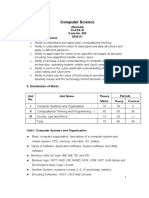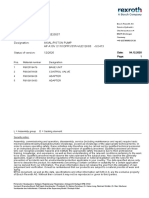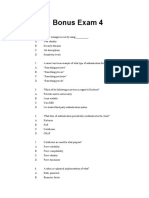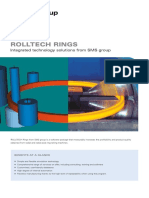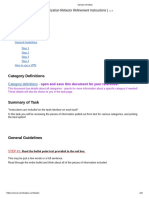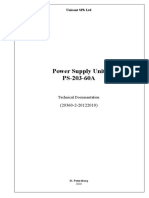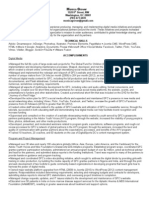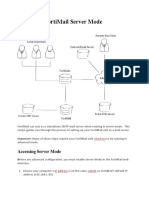0% found this document useful (0 votes)
10 views3 pagesCourse 5
The document outlines the course details for 'Introduction to Computer Science' (CS 101) for Fall 2025, including the instructor, schedule, and location. It provides a week-by-week course outline covering topics such as computer hardware, programming, algorithms, and cybersecurity, along with associated readings and assignments. Additionally, it includes a sample lecture note for Week 6 focused on control structures, detailing learning objectives, lecture outline, teaching tips, assignments, and additional resources.
Uploaded by
Pioneer PaperboyCopyright
© © All Rights Reserved
We take content rights seriously. If you suspect this is your content, claim it here.
Available Formats
Download as PDF, TXT or read online on Scribd
0% found this document useful (0 votes)
10 views3 pagesCourse 5
The document outlines the course details for 'Introduction to Computer Science' (CS 101) for Fall 2025, including the instructor, schedule, and location. It provides a week-by-week course outline covering topics such as computer hardware, programming, algorithms, and cybersecurity, along with associated readings and assignments. Additionally, it includes a sample lecture note for Week 6 focused on control structures, detailing learning objectives, lecture outline, teaching tips, assignments, and additional resources.
Uploaded by
Pioneer PaperboyCopyright
© © All Rights Reserved
We take content rights seriously. If you suspect this is your content, claim it here.
Available Formats
Download as PDF, TXT or read online on Scribd
/ 3
Course: Introduction to Computer Science
Course Code: CS 101
Semester: Fall 2025
Instructor: Prof. Alex Kim
Class Schedule: Tuesdays & Thursdays, 2:00–3:30 PM
Location: Technology Center, Room 110
Course Outline
Week Lecture Topic Key Concepts Assignments/Readings
Course Overview & History of Syllabus, early computers, Read Ch. 1, Forum intro
1
Computing pioneers post
CPU, memory, storage,
2 Computer Hardware & Software Read Ch. 2, Quiz 1
input/output, OS basics
Number Systems & Data Binary, decimal, hexadecimal,
3 Read Ch. 3, Worksheet 1
Representation ASCII
Algorithm design, flowcharts, Read Ch. 4, Algorithm
4 Algorithms & Problem Solving
pseudocode exercise
Programming languages, syntax,
5 Introduction to Programming Read Ch. 5, Install Python
variables
6 Control Structures Conditionals, loops, basic logic Read Ch. 6, Quiz 2
Functions & Modular Defining, calling, parameters, Read Ch. 7, Coding
7
Programming return values assignment 1
Data Structures: Lists & Lists, arrays, dictionaries, basic
8 Read Ch. 8, Worksheet 2
Dictionaries operations
Read Ch. 9, Coding
9 File Input/Output Reading/writing files, file formats
assignment 2
Introduction to Object-Oriented Classes, objects, attributes,
10 Read Ch. 10, Quiz 3
Programming methods
Software Development & Testing, debugging, IDEs, error Read Ch. 11, Debugging
11
Debugging handling exercise
Week Lecture Topic Key Concepts Assignments/Readings
12 Databases & SQL Basics Tables, queries, basic SQL Read Ch. 12, SQL practice
Internet basics, protocols, web
13 Networking & Internet Read Ch. 13, Group project
concepts
Security principles, privacy,
14 Cybersecurity & Ethics Read Ch. 14, Reflection
ethical computing
15 Review & Final Exam Comprehensive review, Q&A Final Exam
Sample Weekly Lecture Note (Week 6)
Lecture Topic: Control Structures
Learning Objectives
• Understand and apply conditional statements (if, else, elif).
• Use loops (for, while) to repeat actions.
• Write simple programs that make decisions and repeat tasks.
Lecture Outline
1. Introduction (5 min)
• Warm-up: “Where do you see decision-making or repetition in daily life?”
• Recap: Variables and basic syntax from last class.
2. Conditional Statements (15 min)
• Syntax: if, else, elif in Python (examples on projector).
• Comparison operators: ==, !=, <, >, <=, >=.
• In-class exercise: Write a program to check if a number is positive, negative, or zero.
3. Loops (20 min)
• For loops: iterating over ranges and lists.
• While loops: repeating until a condition is met.
• Common pitfalls: infinite loops, off-by-one errors.
• Live coding: Sum all numbers from 1 to 10.
4. Combining Conditionals and Loops (10 min)
• Nested structures: using if statements inside loops.
• Example: Print all even numbers from 1 to 20.
• Student activity: Write a program to find the factorial of a number.
5. Debugging Practice (5 min)
• Demonstrate common errors and how to fix them.
• Quick group challenge: Find and fix the bug in a provided code snippet.
6. Summary & Q&A (5 min)
• Recap key concepts.
• Preview next week: Functions & Modular Programming.
Teaching Tips & Notes
• Use live coding to model problem-solving.
• Encourage students to ask “What if?” and test code variations.
• Remind students to comment code for clarity.
• Offer extra help for those new to programming-office hours and peer tutoring.
Assignments
• Read Chapter 6: Control Structures.
• Complete Quiz 2 (due Friday).
• Coding Exercise: Write a program that asks for a user’s age and prints a message based on age
group.
Additional Resources
































